| |
The mystery solved...
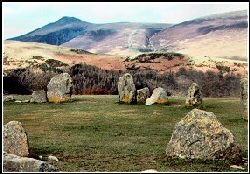 There
are many relics in Britain and Europe dating from the Neolithic period, more commonly called
the Late Stone and Early Bronze Ages including some of our most well known national landmarks,
such as Stonehenge or Avebury. It has long been believed that they are aligned on the rising or
setting moon or sun at significant times of year, such as Midsummer sunrise. But beyond that,
their purpose has remained unexplained, and has been assigned to ritual' use by the
archaeological community. Recently, a theory has been put forward that throws new light on the
use of these structures, and it is a ritual that we are all familiar with that of meeting up
and competing with dogs! There
are many relics in Britain and Europe dating from the Neolithic period, more commonly called
the Late Stone and Early Bronze Ages including some of our most well known national landmarks,
such as Stonehenge or Avebury. It has long been believed that they are aligned on the rising or
setting moon or sun at significant times of year, such as Midsummer sunrise. But beyond that,
their purpose has remained unexplained, and has been assigned to ritual' use by the
archaeological community. Recently, a theory has been put forward that throws new light on the
use of these structures, and it is a ritual that we are all familiar with that of meeting up
and competing with dogs!
There are many stone
circles, and they have been the subject of study by archaeologists and antiquarians for many
decades. It now seems that agility could be a much older sport than we had supposed but if we
accept that the agility term 'ring' has passed down through the centuries because it originally
described a circular arena, things begin to fall into place.
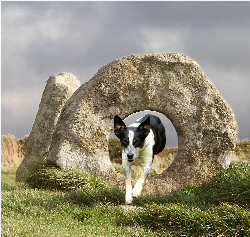 Many
stone circles tend to enclose an area similar to that of a standard agility ring that we use
today, so we can assume that the number of obstacles was roughly similar to now. Of course, the
majority of obstacles themselves would have been made from wood. These would have long since
rotted away, but at least one still exists a 'tyre' jump, hewn from stone that is almost
identical in size and aperture to the modern standard tyre used now, though padding seems to
have been a lower priority. Possibly a layer of local moss could have been used, tied on with
spun yarn or plant stems. The stone 'tyre' is still in usable condition as the photo
demonstrates. It can be found in Cornwall at what appears to be a major agility centre the
area north-east of St Just. Many
stone circles tend to enclose an area similar to that of a standard agility ring that we use
today, so we can assume that the number of obstacles was roughly similar to now. Of course, the
majority of obstacles themselves would have been made from wood. These would have long since
rotted away, but at least one still exists a 'tyre' jump, hewn from stone that is almost
identical in size and aperture to the modern standard tyre used now, though padding seems to
have been a lower priority. Possibly a layer of local moss could have been used, tied on with
spun yarn or plant stems. The stone 'tyre' is still in usable condition as the photo
demonstrates. It can be found in Cornwall at what appears to be a major agility centre the
area north-east of St Just.
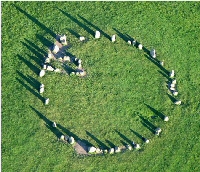 There
are two rings still in reasonable order. On the track approaching the site, there is a single
upright stone covered with carved writing in an ancient script. In the Neolithic period there
was no Agilitynet, and even paper had not been invented, so the rules and schedule would have
been carved on just such a pillar at the entrance to the camping area. Of course, the alignment
of these sites on celestial conjunctions now becomes clear, as the competitors would have used
these to arrive at the venues at the correct time. There
are two rings still in reasonable order. On the track approaching the site, there is a single
upright stone covered with carved writing in an ancient script. In the Neolithic period there
was no Agilitynet, and even paper had not been invented, so the rules and schedule would have
been carved on just such a pillar at the entrance to the camping area. Of course, the alignment
of these sites on celestial conjunctions now becomes clear, as the competitors would have used
these to arrive at the venues at the correct time.
Ring parties
Looked at in this new light, previously mysterious structures such as the rectangular area of
stones within the main circle at Castlerigg in Cumbria become obvious. In the harsher northern
climate, a sturdy scrime/score hut would have been essential. There was some excavation done in
1882 in this grouping of stones which joins on to the eastern side of the circle, but only
charcoal was found clear evidence of a brazier arrangement to keep the ring party warm. As
there is a celestial alignment of the circle to the midwinter rising sun, there must have been
a midwinter agility festival there.
|
The remnants of wooden post-holes found in the vicinity of some stone circles were the
supports for the secretary's tent, which would have been covered with animal skins.
The conjunction of these stone circles with burial sites - and in some cases ritual
altars - denotes either a lack of today's safety consciousness, or, more worryingly, the
possibility that our sport once involved human sacrifice. This could have been either a
penalty for harsh treatment in the ring, or for persistent bad handling.
Another theory is that the burials are those of devoted adherents of the sport, who died
of natural causes and wished to be interred where they had been happiest, and that
burials inside the rings were those of the most respected judges. However, none of the
excavations of these burials have found remains of dogs, only humans, so we should not be
unduly upset.
Even areas where stone was not available in sufficient quantity to build stone circles
were not necessarily devoid of the sport. In many parts of the country, there is evidence
of similar structures made from wood. There is one at Bleasdale in Lancashire that
may have been the show venue for an early, long forgotten precursor to the modern day
Wyre club. |
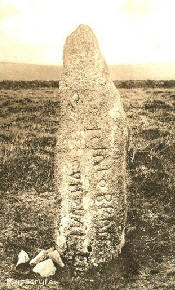
Men Scryfa or 'rule ston |
Mick
Aston, the one off Time Team with the mad jumpers, was reported to have been sobbing into his
pint, muttering 'if only I had realised... my life has been wasted.'
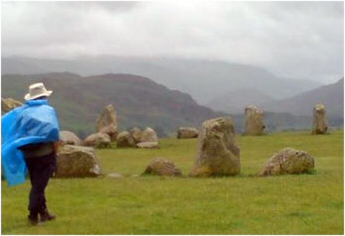 Author
credit... Author
credit...
Laura Sivell is a member of Lune Valley, and runs Ziggy (Intergalactic
Lightning). Ziggy is her first dog who is Medium Grade 6, and they have been competing for
three years. Laura works as a gardener, and Ziggy as her glove-carrying assistant. They live
near Lancaster.
Ziggy is a Morecambe Bay
Shrimp-Hound. Once common dogs amongst the fishing communities of the Morecambe Bay area, with
the recent decline of the shrimping industry, there are now few left. The dogs used to work in
a group, usually five or seven - even numbers were believed to be unlucky - splashing,
splashing through the shallow waters of the bay and driving shoals of shrimps towards the
fishermens' nets. They are also strong swimmers, if need be. Never recognised by the Kennel
Club, they were unknown outside the local area until the author and playwright Peter Tinniswood
brought the breed to public attention along with other Northern dying or lost breeds. ..the
true dogs of the North, killed off by colour television and the advent of one man buses.'
Published 1 April 2009 ha ha ha!
| |
|
 Author
credit...
Author
credit...